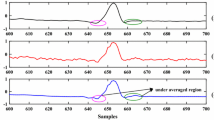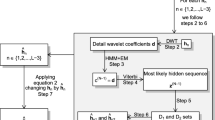Abstract
Electrocardiogram (ECG) has an important reference value in the study of basic cardiac function and pathology. However, ECG signals are easily corrupted by various noises in the acquisition and transmission. Hence, the noise removal in ECG signals is helpful to the diagnosis and analysis. In this paper, both the local sample correlations and nonlocal sample correlations of the ECG signals are utilized to remove noise. According to the local sample correlations, the penalized least squares method is used to remove the noise in the segment. According to the similarity of nonlocal samples, the average of similar segments in different periods can be regarded as a reference estimate for the current signal segment. The effectiveness of the algorithm is verified by adding simulated noises in the MIT-BIH Arrhythmia Database. Compared with some existing methods quantitatively, the signal quality (the improvement in the signal-to-noise ratio, mean square error, and percentage root mean square difference) has been significantly improved. Finally, the proposed method combined with the baseline correction algorithm is applied to raw signals with real noises in ECG-ID Database and gets a favorable visual effect.













Similar content being viewed by others
References
R. Abdollahpoor, N. Lotfivand, Fully adaptive denoising of ECG signals using empirical mode decomposition with the modified indirect subtraction and the adaptive window techniques. Circuits Syst. Signal Process. 39(8), 4021–4046 (2020)
P.S. Addison, Wavelet transforms and the ECG: a review. Physiol. Meas. 26(5), R155-199 (2005)
M. Alfaouri, K. Daqrouq, ECG signal denoising by wavelet transform thresholding. Am. J. Appl. Sci. 5(3), 276–281 (2008)
O. Benrhouma, H. Hermassi et al., Chaotic watermark for blind forgery detection in images. Multimed. Tools Appl. 75(14), 8695–8718 (2016)
M. Blanco-Velasco, B. Weng et al., ECG signal denoising and baseline wander correction based on the empirical mode decomposition. Comput. Biol. Med. 38(1), 1–13 (2008)
S. Chatterjee, R.S. Thakur et al., Review of noise removal techniques in ECG signals. IET Signal Proc. 14(9), 569–590 (2020)
V.S. Chouhan, S.S. Mehta, Total removal of baseline drift from ECG signal. In: International Conference on Computing Theory and Applications, pp. 512–515 (2007)
X.F. Dong, S.P. He et al., Robust fault detection filter design for a class of discrete-time conic-type non-linear Markov jump systems with jump fault signals. IET Control Theory Appl. 14(14), 1912–1919 (2020)
K. Dragomiretskiy, D. Zosso, Variational mode decomposition. IEEE Trans. Signal Process. 62(3), 531–544 (2013)
A.K. Dwivedi, H. Ranjan et al., Noise reduction in ECG signal using combined ensemble empirical mode decomposition method with stationary wavelet transform. Circuits Syst. Signal Process. 40(2), 827–844 (2021)
P.H. Eilers, A perfect smoother. Anal. Chem. 75(14), 3631–3636 (2003)
G. Han, B. Lin et al., Electrocardiogram signal denoising based on empirical mode decomposition technique: an overview. J. Instrum. 12(03), P03010 (2017)
A. Hashemi, M. Rahimpour, et al. Dynamic Gaussian filter for muscle noise reduction in ECG signal. In: Iranian Conference on Electrical Engineering, pp. 120–124 (2015)
W. Jenkal, R. Latif et al., An efficient algorithm of ECG signal denoising using the adaptive dual threshold filter and the discrete wavelet transform. Biocybern. Biomed. Eng. 36(3), 499–508 (2016)
M.A. Kabir, C. Shahnaz, Denoising of ECG signals based on noise reduction algorithms in EMD and wavelet domains. Biomed. Signal Process. Control 7(5), 481–489 (2012)
S. Lahmiri, Comparative study of ECG signal denoising by wavelet thresholding in empirical and variational mode decomposition domains. Healthc. Technol. Lett. 1(3), 104–109 (2014)
Y.L. Li, F.W. Liu et al., Time-fractional diffusion equation for signal smoothing. Appl. Math. Comput. 326, 108–116 (2018)
Y.-D. Lin, Y.H. Hu, Power-line interference detection and suppression in ECG signal processing. IEEE Trans. Biomed. Eng. 55(1), 354–357 (2007)
R. Liu, Y. Wang, et al. An algorithm study of electrocardiogram signal denoising by using wavelet transform method. In: Journal of Physics: Conference Series. IOP Publishing, 1345(5): 052063
T.S. Lugovaya, Biometric human identification based on electrocardiogram. Master's thesis, Faculty of Computing Technologies and Informatics, Electrotechnical University ‘LETI’, Saint-Petersburg, Russian Federation (2005)
R.J. Martis, U.R. Acharya et al., ECG beat classification using PCA, LDA, ICA and discrete wavelet transform. Biomed. Signal Process. Control 8(5), 437–448 (2013)
N. Mohan, S. Kumar et al., Modified variational mode decomposition for power line interference removal in ECG signals. Int. J. Electr. Comput. Eng. 6(1), 151 (2016)
G.B. Moody, R.G. Mark, The impact of the MIT-BIH arrhythmia database. IEEE Eng. Med. Biol. Mag. 20(3), 45–50 (2001)
N. Mourad, ECG denoising algorithm based on group sparsity and singular spectrum analysis. Biomed. Signal Process. Control 50, 62–71 (2019)
M. Rakshit, S. Das, An efficient ECG denoising methodology using empirical mode decomposition and adaptive switching mean filter. Biomed. Signal Process. Control 40, 140–148 (2018)
V.A. Rani, B. Tirumalareddy et al., ECG signal denoising using EEMD and adaptive filter. Res. J. Pharm., Biol. Chem. Sci. 7(4), 2734–2741 (2016)
R. Sameni, M.B. Shamsollahi et al., A nonlinear Bayesian filtering framework for ECG denoising. IEEE Trans. Biomed. Eng. 54(12), 2172–2185 (2007)
A. Savitzky, M.J. Golay, Smoothing and differentiation of data by simplified least squares procedures. Anal. Chem. 36(8), 1627–1639 (1964)
B.N. Singh, A.K. Tiwari, Optimal selection of wavelet basis function applied to ECG signal denoising. Digit. Signal Process. 16(3), 275–287 (2006)
V. Stojanovic, N. Nedic, A nature inspired parameter tuning approach to cascade control for hydraulically driven parallel robot platform. J. Optim. Theory Appl. 168(1), 332–347 (2016)
V. Stojanovic, S. He et al., State and parameter joint estimation of linear stochastic systems in presence of faults and non-Gaussian noises. Int. J. Robust Nonlinear Control 30(16), 6683–6700 (2020)
V. Stojanovic, D. Prsic, Robust identification for fault detection in the presence of non-Gaussian noises: application to hydraulic servo drives. Nonlinear Dyn. 100(3), 2299–2313 (2020)
B.H. Tracey, E.L. Miller, Nonlocal means denoising of ECG signals. IEEE Trans. Biomed. Eng. 59(9), 2383–2386 (2012)
Q. Ye, N. Cai et al., An effective optimization scheme for ECG signal denoising via low-rank matrix decomposition. Circuits Syst. Signal Process. 38(1), 138–152 (2019)
Acknowledgements
The work was partly supported by the National Natural Science Foundation of China (Grant: 61671010), the Natural Science Foundation of Jiangsu Province of China (Grant: BK20161535), and the Qing Lan Project of Jiangsu Province (Grant: B2018Q03).
Author information
Authors and Affiliations
Corresponding author
Ethics declarations
Conflict of interest
We declare that we do not have any commercial or associative interest that represents a conflict of interest in connection with the work submitted.
Data Availability Statement
The data that support the findings of this study are openly available in the MIT-BIH Arrhythmia Database (https://physionet.org/content/mitdb/1.0.0/), reference number [23] and ECG-ID Database (https://physionet.org/content/ecgiddb/1.0.0/), reference number [20].
Additional information
Publisher's Note
Springer Nature remains neutral with regard to jurisdictional claims in published maps and institutional affiliations.
Rights and permissions
About this article
Cite this article
Li, K., Zhang, Y., Li, Y. et al. Local Penalized Least Squares Combined with the Segment Similarity for ECG Denoising. Circuits Syst Signal Process 41, 532–550 (2022). https://doi.org/10.1007/s00034-021-01795-6
Received:
Revised:
Accepted:
Published:
Issue Date:
DOI: https://doi.org/10.1007/s00034-021-01795-6




